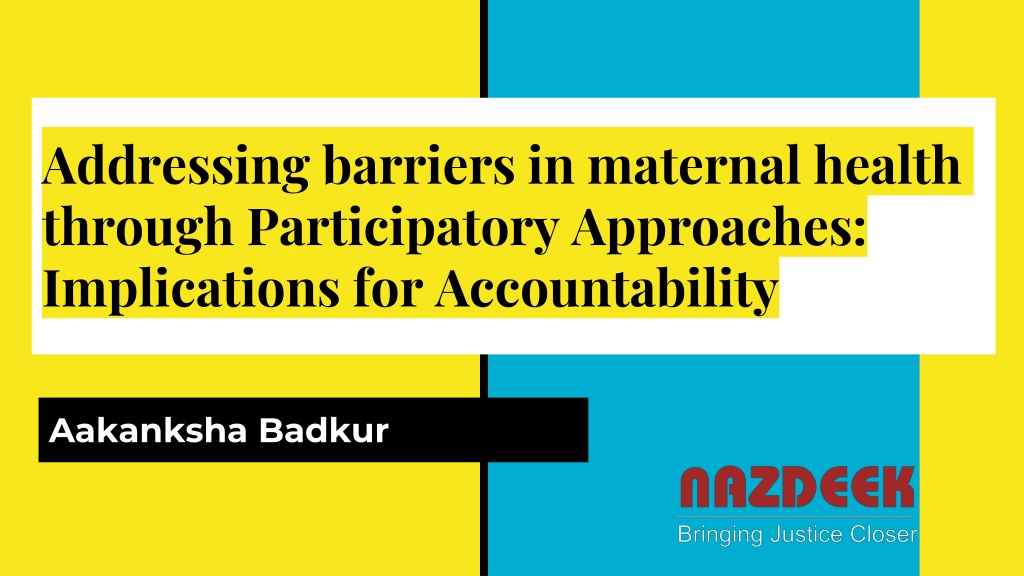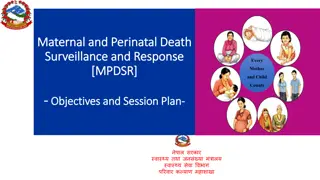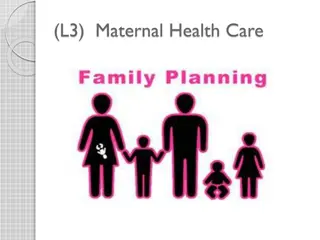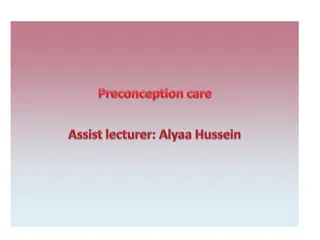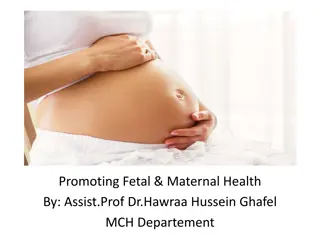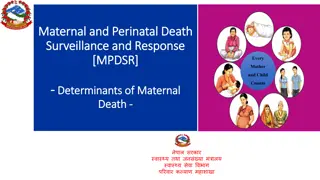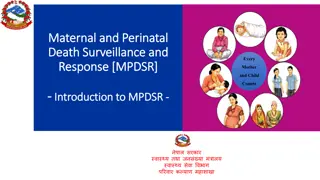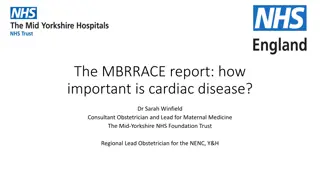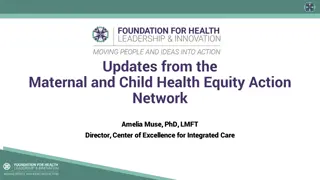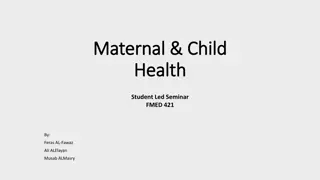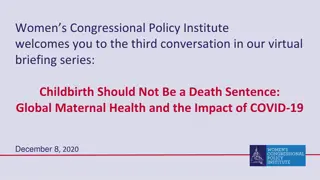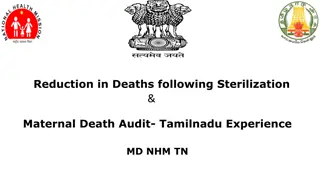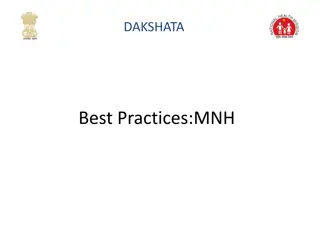Addressing Barriers in Maternal Health: A Participatory Approach for Accountability
This research focused on addressing barriers in maternal health through participatory approaches due to low utilization of existing maternal health services, poor quality of care, strain on public health infrastructures, under-reporting, and long-term impacts of the pandemic. The intervenor, a legal practitioner consulting with Nazdeek, engaged with pregnant and lactating women from marginalized communities in Delhi to advocate for socio-economic rights. The timeline highlights the steps taken, including identification of women, interviews, petition drafting, and legal proceedings to address rights violations.
Download Presentation

Please find below an Image/Link to download the presentation.
The content on the website is provided AS IS for your information and personal use only. It may not be sold, licensed, or shared on other websites without obtaining consent from the author. Download presentation by click this link. If you encounter any issues during the download, it is possible that the publisher has removed the file from their server.
E N D
Presentation Transcript
Addressing barriers in maternal health through Participatory Approaches: Implications for Accountability Aakanksha Badkur
Why was this research necessary? 1. Low utilization of existing Maternal Health Services and barriers in access by women belonging to Low Income Households and marginalized communities 2. Evidence of poor quality of care and disproportionate impact of interruptions 3. Strain on public health infrastructures due to COVID and mass casualties 4. Under-reporting by government agencies acts as a major challenge to understanding the full scope of maternal health inequity 5. Growing body of research anticipating long-term impacts of the pandemic on Maternal and Child Health. 6. Need for monitoring of services and the absence for grievance and response mechanisms in existing systems
Social Context and Positionality of Intervenor Profile and positionality of Intervenor Legal practitioner - consulting with Nazdeek, a legal empowerment organization As part of work - engage with women belonging to the marginalized communities towards advocating for socio-economic rights. The legal empowerment model uses participatory tools and methods to better educate the methods and strategies adopted, and help mitigateand manage potential risks. Social Context and Sampling of Participants Pregnant and lactating women from 5 communities in Delhi were identified, - - - - Two unauthorized colonies in North East Delhi; A village falling within the O-Zone area in North-East Delhi along the banks of river Yamuna, A Jhuggi Jhopri Cluster in South Delhi, and A government rehabilitation colony in West Delhi. The residents of these communities and areas belong to low income households, and are primarily reliant on government healthcare infrastructure.
Timeline of Steps Taken Identification of women through existing networks -MARCH 2021 Informed consent Interviews conducted and resources shared -APRIL -JUNE 2021 Informed consent Second round of interviews conducted + Literature review of Government s COVID response JUNE -JULY 2021 Key findings of Literature review shared with women and options for grievance redressal discussed - AUGUST 2020 Informed consent Petition drafted under Writ Jurisdiction of the High Court by legal team and scrutiny of supporting document -SEPTEMBER 2021 Consent as per HC Rules Petition filed and listed -Court issued notice to Govt. OCTOBER 2021 Govt. Authorities filed their replies -OCT -NOV 2021 Petitioners file details and specifics of violations on affidavit - as directed by Court - JANUARY 2022 Next date of hearing -SEPTEMBER 2022
Rights violations which emerged from the conversations 1. Closure of primary/secondary healthcare centres and poor availability and accessibility of services 2. Expansion of duties of frontline workers and impacts on MH services 3. Absence of a standard referral system at hospitals and denial of services 4. Abuse and violence faced at the hands of hospital staff 5. Absence of information as well as grievance redressal mechanisms 6. Out-of-pocket expenses and financial hardship
Key forms of grievance redressal discussed with women Different grievance redressal options which were available were reviewed and discussed with the women, through multiple telephonic and virtual consultations with women and the legal team, many of whom were also attended by members of the women s families. Women often preferred to have female family members, such as mother, mother-in-law, or sister-in-law, present in these consultations. Options discussed: 1. 2. Filing online complaints through various government mechanisms (for example the Delhi Government s Public Grievance Monitoring System), 3. Sending written representations to relevant stakeholders (such as Department of Women and Child Development and Department of Health and Family Welfare), 4. Approaching local authorities for redressal (such as their MLA or MCD Councilor) 5. Approaching the Courts through legal action. In-person advocacy (contingent on safety and availability of stakeholders),
Womens perspective on grievance redressal Women reasoned that they did not wish to take an adversarial approach to address these violations, and would not wish to give personal identity information, or details of the rights violations and abuse faced to a larger audience, which would become part of government records. Many women also indicated that they would prefer more indirect channels of communication and redressal, which suggests the absence of responsive and supportive redressal mechanisms.
Womens concerns about approaching the courts Absence of clarity and understanding about the litigation process, including whether they would be required to visit the Court on a regular basis, and give verbal testimonies before the lawyers and Judges, and be subjected to questioning in Court. The duration of the litigation process, and possible costs associated with it. The possibility of push-back from family members, including husbands and inlaws, as well as community health workers and frontline workers. The possibility of denial of services and entitlements from facilities and institutions named in the petition as a form of backlash. Potential social fallout and deterioration of community relations as a result of being viewed as pugnacious and litigious.
Process of obtaining informed consent for the litigation Explaining the scope and nature of the litigation, what it means to approach the High Courts under a rights-centric writ jurisdiction, and the powers of the Court to pass orders and directions. Details to be provided in the present petition, including what narration of facts would be included, and the option of omitting names and specifics of individuals involved as strategy to mitigate the risks for the petitioners. How the law and legal precedents interpreted and understood the Right to Safe Motherhood as being an integral part of the Right to Life guaranteed under Article 21 of the Indian Constitution. The reliefs which would be prayed for in the writ petition, including case-specific prayers as well as general directions for government hospitals and health care institutions. The general objectives and expectations from the litigation, including a tentative time frame and potential outcomes.
Enabling Factors (as perceived by the Intervenor) All 4 women were literate, and were able to read and understand the scheme documents shared with them initially. The women were in possession of their medical records and documentation from various ANC visits to healthcare facilities, either in part or whole, which helped establish the timeline for the rights violations experienced by them. All four women were in different stages of their first pregnancy, and wished to deliver at government hospitals during the pandemic. The four women received support from their family members and spouses to pursue the litigation, and were of the view that apart from their individual cases, pregnant and lactating women needed to receive free of cost and quality services, especially during the ongoing pandemic.
Ways in which participatory approaches were integrated Return and reflect approach Act of questioning systems and what needs they serve
How PAR guided the process Tensions encountered and emerging conflicts Between women and the facilitator Between women and family members Between women and frontline workers Between women and the community
What questions emerged during the research and intervention Key questions which emerged were: Concept of neutrality, harm, and the impetus to act Consultative versus paternalistic - creating space for experience and expression Adversarial versus Collaborative - identification of allies - Khakha
Inviting conversations with the community How do you imagine accountability within these negotiations? Ways to champion community learning
By loving the question itself, we may one day stumble upon the answer. - Unknown
